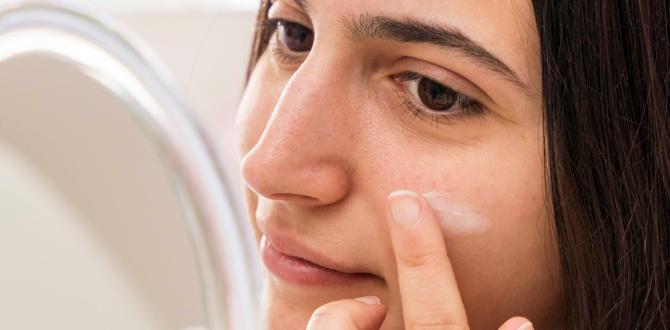Do you ever feel like your skin is more dry and rough as you get older? You’re not alone! Many people who face aging skin also struggle with dry skin. It can be frustrating and uncomfortable. But the good news is, a beginner dry skin routine can really help.
Imagine waking up each morning to soft, hydrated skin. Sounds nice, right? With the right steps, you can achieve that glow! A proper routine isn’t just for beauty experts. Anyone can start a simple routine tailored to their skin needs, especially when it comes to aging.
Did you know that as we age, our skin loses moisture more quickly? That means caring for dry skin becomes even more important. Let’s dive into easy, effective ways to build your beginner dry skin routine for aging skin. You deserve to feel comfortable in your own skin, no matter your age!
Essential Beginner Dry Skin Routine For Aging Skin

Beginner Dry Skin Routine for Aging Skin
Aging skin often feels dry and needs extra care. A good routine helps it stay healthy. First, start with a gentle cleanser. It removes dirt without stripping natural oils. Next, apply a rich moisturizer to hydrate the skin. Look for ingredients like hyaluronic acid and ceramides. Don’t forget sunscreen! It protects against sun damage and keeps skin youthful. Drinking water also helps keep your skin plump. Remember, simple steps can make a big difference!Understanding Aging Skin
Characteristics of aging skin. How dryness affects aging skin.Aging skin shows unique signs. It can become thinner, less elastic, and more fragile. Common characteristics include wrinkles, fine lines, and age spots. As skin ages, it loses moisture, leading to dryness. This can make wrinkles look deeper and skin feel rough. When skin is dry, it can also itch or feel tight.
- Thinner texture
- More wrinkles
- Less elasticity
- Increased dryness
How does dryness affect aging skin?
Dryness can make aging skin more vulnerable to damage. It can lead to irritation and increase the risk of infections. Keeping skin hydrated helps maintain its softness and resilience.
Identifying Dry Skin Symptoms
Common signs of dry skin. Differentiating between dry and dehydrated skin.Recognizing the signs of dry skin is key to caring for it. Common symptoms include flakiness, itchiness, and a tight feeling. Your skin might look dull or rough. It’s important to know the difference between dry and dehydrated skin. Dry skin lacks oil, while dehydrated skin lacks water. Here are some signs:
- Dry Skin: Rough, flaky patches
- Dehydrated Skin: Translucent, dull appearance
- Dry Skin: Itchy and tight feelings
- Dehydrated Skin: Dark circles and dryness
What are the main symptoms of dry skin?
Common symptoms include flakiness, itchiness, and a tight feeling. Your skin might also look dull or rough. Be mindful of these signs to help your skin stay healthy!
Essential Ingredients for Dry Skin Care
Key ingredients to look for in products. Benefits of moisturizing ingredients (e.g., hyaluronic acid, ceramides).To care for dry skin, look for special ingredients that help. Key ones include hyaluronic acid and ceramides. Hyaluronic acid acts like a sponge, holding moisture in the skin. This keeps it plump and soft. Ceramides help seal in that moisture, forming a protective barrier. Together, they can make your skin feel smooth and hydrated. Here are some important ingredients to find:
- Hyaluronic Acid: Locks in moisture.
- Ceramides: Strengthens the skin barrier.
- Glycerin: Attracts water to the skin.
- Shea Butter: Provides deep nourishment.
What ingredients help with dry skin?
Ingredients like hyaluronic acid and ceramides are great for dry skin. They keep it moist and healthy. Always check product labels for these helpful ingredients!
Step-by-Step Beginner Dry Skin Routine
Morning routine essentials. Nighttime skincare steps.Starting the day right helps your skin feel fresh. Here’s a simple morning routine:
- Cleanser: Gently wash your face with a mild cleanser.
- Toner: Use a hydrating toner to balance your skin.
- Moisturizer: Apply a rich cream to lock in moisture.
- Sunscreen: Always finish with SPF to protect your skin from the sun.
Your nighttime routine is just as important! Follow these steps before bed:
- Cleanser: Wash away dirt and makeup.
- Serum: Apply a nourishing serum for extra hydration.
- Moisturizer: Use a thick cream to repair overnight.
What is the best routine for dry skin?
The best routine for dry skin involves using gentle cleansers and heavy moisturizers both day and night to keep skin hydrated.
Recommended Products for Each Step
Top cleansers for dry skin. Best moisturizers and serums for aging skin.Choosing the right products can make all the difference for dry aging skin. First up, cleansers! Look for ones that hydrate while washing away dirt. They should feel like a gentle hug for your face. Here are some top picks:
| Product | Description |
|---|---|
| Gentle Cream Cleanser | Rich and creamy, perfect for dry skin! |
| Hydrating Foam Cleanser | Light and fun, like bubbles in your bath! |
Now, for moisturizers and serums. Selecting these is like finding your favorite dessert—each one makes you feel good! Look for products with ingredients like hyaluronic acid and vitamin E. They are like superheroes for your skin. Consider:
| Product | Description |
|---|---|
| Super Nourishing Cream | Long-lasting hydration that feels dreamy! |
| Anti-Aging Serum | Busts dryness and fine lines like a champ! |
Use these products regularly, and your skin will be singing, “Thank you!”
Additional Tips for Maintaining Hydration
Importance of drinking water. Humidifiers and their role in skin hydration.Staying hydrated is crucial for your skin. Drinking enough water helps maintain a soft and smooth appearance. Aim for eight glasses a day, or about 2 liters. It makes a big difference!
Using a humidifier can also help. It adds moisture to the air, which is great for dry skin. A humidifier works especially well in winter when the air is dry. Keeping your skin healthy is easy with a few simple steps.
How does water impact my skin?
Water keeps your skin plump and youthful. Dehydration can lead to dryness and fine lines.
Tips for using humidifiers:
- Place it in your bedroom at night.
- Fill it with clean water regularly.
- Keep it on low to prevent over-hydration.
Common Mistakes to Avoid
Overexfoliating and its effects. Using harsh products.Many people think that scrubbing hard will remove dry skin. This is not true. Overexfoliating can damage your skin. It may lead to redness, irritation, and even more dryness. You should also avoid using harsh products. These can strip away natural oils and cause more problems. Instead, use gentle cleansers and moisturizers. Always listen to your skin’s needs!
What happens if you exfoliate too much?
Exfoliating too much can thin your skin, making it sensitive and prone to damage. This may lead to inflammation and discomfort.
Tips for gentle care:
- Choose mild cleansers.
- Limit exfoliation to once a week.
- Moisturize after cleansing.
Consulting with a Dermatologist
When to seek professional advice. Common treatments for aging dry skin.Sometimes, skin feels dry and rough, especially as we grow older. It’s important to know when to see a dermatologist. If normal creams don’t help, it’s time for advice. A pro can check for skin issues. Common treatments include:
- Moisturizers with hyaluronic acid
- Prescription creams
- Gentle exfoliation
These can make a big difference!
When should I see a dermatologist?
If dry skin lasts for weeks or worsens, you should see a doctor. It’s best to get expert help when you notice redness, itchiness, or cracking.
Conclusion
In summary, a beginner dry skin routine for aging skin focuses on hydration and gentle care. Start with a nourishing cleanser, followed by a rich moisturizer. Don’t forget sunscreen daily to protect against damage. You can also try serums with hyaluronic acid or antioxidants. For more tips, explore articles on skin-friendly ingredients and routines tailored for your age.FAQs
What Are The Best Moisturizing Ingredients To Look For In Products For Dry, Aging Skin?When choosing products for dry, aging skin, look for ingredients like hyaluronic acid, glycerin, and ceramides. Hyaluronic acid helps hold water in your skin. Glycerin draws moisture, keeping your skin soft. Ceramides create a barrier to lock in hydration. Together, these ingredients help your skin feel smooth and healthy.
How Often Should I Exfoliate If I Have Dry, Aging Skin, And What Types Of Exfoliants Are Most Effective?If you have dry, aging skin, you should exfoliate once or twice a week. This helps remove dead skin and makes your skin feel fresh. Use gentle exfoliants like sugar scrubs or those with mild acids. These types will clean without hurting your skin. Always remember to hydrate your skin afterward!
What Is A Suitable Cleansing Routine For Dry Skin That Is Also Showing Signs Of Aging?To care for dry, aging skin, start by using a gentle cleanser. Look for one that adds moisture instead of stripping it away. Cleanse your face twice a day—once in the morning and once at night. After washing, use a good moisturizer to help keep your skin soft and smooth. Lastly, drink plenty of water to help your skin stay healthy from the inside!
Are There Specific Serums Or Treatments Recommended For Improving Texture And Hydration In Dry, Aging Skin?Yes, there are special serums and treatments for dry, aging skin. Look for ones with hyaluronic acid, which helps hold water in your skin. You can also use serums with vitamins C and E for extra help. These can make your skin feel softer and look better. Always remember to apply moisturizer after using these treatments!
How Can I Incorporate Sun Protection Into My Dry Skin Routine Without Causing Further Dryness Or Irritation?To protect your skin from the sun, start with a gentle moisturizer. Look for a sunscreen with SPF 30 or higher. Choose a sunscreen that says “hydrating” or “for dry skin.” Apply it on your face and any skin that shows. Always put it on before you go outside, and reapply every two hours.
